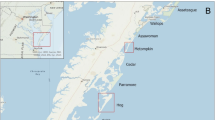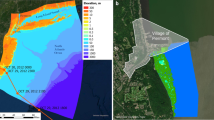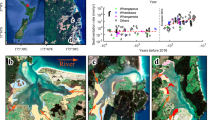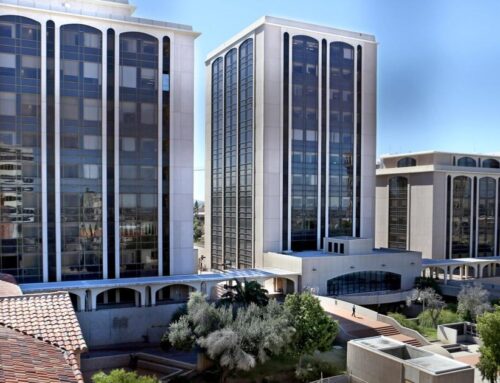Ecomorphodynamics of coastal foredune evolution
May 22, 2025
Abstract
Globally, along sandy coastlines, foredunes support ecosystem services including provision of habitat and protection of communities from waves and storm surge. In this Review, we discuss the interactions between sand transport and vegetation processes (ecomorphodynamics) that give rise to the foredune-building feedback as illuminated by empirical and modelling studies. Foredune shape and alongshore continuity depend primarily on sand supply, vegetation density and growth form. For instance, low-lying, creeping herbaceous species tend to form short embryo dunes, whereas tall, dense grasses that grow vertically tend to form tall, narrow foredunes. Climate and weather events, herbivory and anthropogenic disturbances of varying scale affect the foredune-building feedback. For example, small local scale disturbances, such as herbivory or trampling, cause local vegetation loss and erosion. Management activities, such as beach nourishment, can increase foredune sand supply, leading to foredune rebuilding, although the presence of infrastructure on the back beach can inhibit foredune development. At a regional scale, hurricanes and tropical storms cause substantial dune erosion and overwash, potentially resetting the foredune-building process. Sea-level rise exacerbates the effects of storms, leading to increased erosion, saltwater intrusion and a potential landward shift in foredune location. Future research should prioritize integrated ecomorphodynamic observations and modelling to fill critical knowledge gaps and address the effects of changing climate on the foredune-building process.
This is a preview of subscription content, access via your institution
Access options
Access Nature and 54 other Nature Portfolio journals
Get Nature+, our best-value online-access subscription
$29.99 /Â 30Â days
cancel any time
Subscribe to this journal
Receive 12 digital issues and online access to articles
$119.00 per year
only $9.92 per issue
Buy this article
- Purchase on SpringerLink
- Instant access to full article PDF
Prices may be subject to local taxes which are calculated during checkout
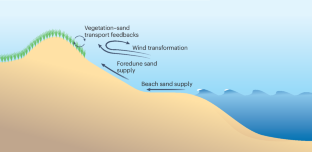
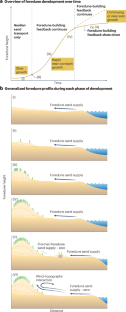

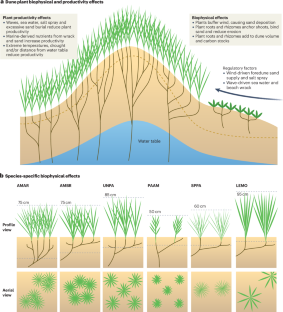
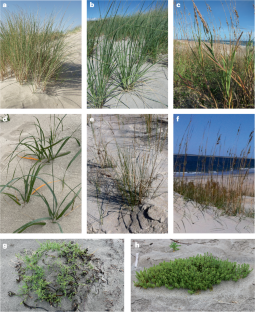
Similar content being viewed by others
References
-
de Freitas, J. G. A Global Environmental History of Coastal Dunes https://doi.org/10.4324/9781003317388 (Routledge, 2024).
-
Luijendijk, A. et al. The state of the world’s beaches. Sci. Rep. 8, 6641 (2018).
-
Sallenger, A. H. Storm impact scale for barrier islands. J. Coast. Res. 16, 890–895 (2000).
-
Green, M. D. & Miller, T. E. Germination traits explain deterministic processes in the assembly of early successional coastal dune vegetation. Estuar. Coast. 42, 1097–1103 (2019).
-
Miller, D. L., Thetford, M. & Schneider, M. Distance from the Gulf influences survival and growth of three barrier island dune plants. J. Coast. Res. 4, 261–266 (2008).
-
Arkema, K. K. et al. Coastal habitats shield people and property from sea-level rise and storms. Nat. Clim. Change 3, 913–918 (2013).
-
Ruggiero, P., Komar, P. D., McDougal, W. G., Marra, J. J. & Beach, R. A. Wave runup, extreme water levels and the erosion of properties backing beaches. J. Coast. Res. 17, 407–419 (2001).
-
Biel, R. G., Hacker, S. D., Ruggiero, P., Cohn, N. & Seabloom, E. W. Coastal protection and conservation on sandy beaches and dunes: context�dependent tradeoffs in ecosystem service supply. Ecosphere 8, 1791 (2017).
-
Itzkin, M. Anthropogenic influences on coastal dune dynamics: exploring past and future effects of management interventions on a developed barrier island (The University of North Carolina at Chapel Hill, 2021).
-
Carranza, M. L. et al. Assessing land take and its effects on dune carbon pools. An insight into the Mediterranean coastline. Ecol. Indic. 85, 951–955 (2018).
-
Jay, K. et al. Quantifying the relative importance of sand deposition and dune grasses to carbon storage in US Central Atlantic Coast dunes. Estuar. Coast. 48, 60 (2025).
-
Gieder, K. D. et al. A Bayesian network approach to predicting nest presence of the federally-threatened piping plover (Charadrius melodus) using barrier island features. Ecol. Model. 276, 38–50 (2014).
-
McLachlan, A. Ecology of coastal dune fauna. J. Arid. Environ. 21, 229–243 (1991).
-
Zarnetske, P. L., Seabloom, E. W. & Hacker, S. D. Non�target effects of invasive species management: beachgrass, birds, and bulldozers in coastal dunes. Ecosphere 1, 1–20 (2010).
-
Barbier, E. B. et al. The value of estuarine and coastal ecosystem services. Ecol. Monogr. 81, 169–193 (2011).
-
Drius, M. et al. Not just a sandy beach. The multi-service value of Mediterranean coastal dunes. Sci. Total Environ. 668, 1139–1155 (2019).
-
Solan, M. et al. Biological–physical interactions are fundamental to understanding and managing coastal dynamics. R. Soc. Open Sci. 10, 230155 (2023).
-
Farrell, E. J., Delgado Fernandez, I., Smyth, T., Li, B. & Swann, C. Contemporary research in coastal dunes and aeolian processes. Earth Surf. Process. Landf. 49, 108–116 (2024).
-
Short, A. D. & Hesp, P. A. Wave, beach and dune interactions in southeastern Australia. Mar. Geol. 48, 259–284 (1982).
-
Psuty, N. P. Holocene sea level in New Jersey. Phys. Geogr. 7, 156–167 (1986).
-
Hesp, P. A. A review of biological and geomorphological processes involved in the initiation and development of incipient foredunes. Proc. R. Soc. Edinb. Sect. B Biol. Sci. 96, 181–201 (1989).
-
Intergovernmental Panel on Climate Change (IPCC). Climate Change 2022 — Impacts, Adaptation and Vulnerability Vol. 3056 https://doi.org/10.1017/9781009325844 (Cambridge Univ. Press, 2023).
-
Sweet, W. V. et al. Global and Regional Sea Level Rise Scenarios for the United States: Updated Mean Projections and Extreme Water Level Probabilities Along U.S. 111 (2022).
-
Knutson, T. R., Sirutis, J. J., Bender, M. A., Tuleya, R. E. & Schenkel, B. A. Dynamical downscaling projections of late twenty-first-century U.S. landfalling hurricane activity. Clim. Change 171, 28 (2022).
-
Garcia-Lozano, C., Pintó, J. & Roig-Munar, F. X. Set of indices to assess dune development and dune restoration potential in beach–dune systems on Mediterranean developed coasts. J. Environ. Manage. 259, 109754 (2020).
-
Nordstrom, K. Beach and Dune Restoration (Cambridge Univ. Press, 2008).
-
Derijckere, J., Strypsteen, G. & Rauwoens, P. Early-stage development of an artificial dune with varying plant density and distribution. Geomorphology 437, 108806 (2023).
-
Anarde, K. A., Moore, L. J., Murray, A. B. & Reeves, I. R. B. The future of developed barrier systems: 1. Pathways toward uninhabitability, drowning, and rebound. Earth’s Future 12, 2023EF003672 (2024).
-
Anarde, K. A., Moore, L. J., Murray, A. B. & Reeves, I. R. B. The future of developed barrier systems: 2. Alongshore complexities and emergent climate change dynamics. Earth’s Future 12, 2023EF004200 (2024).
-
Council Directive 92/43/EEC of 21 May 1992 on the conservation of natural habitats and of wild fauna and flora. European Union http://data.europa.eu/eli/dir/1992/43/2013-07-01 (1992).
-
Robin, N. et al. 150 years of foredune initiation and evolution driven by human and natural processes. Geomorphology 374, 107516 (2021).
-
Zinnert, J. C. et al. Connectivity in coastal systems: barrier island vegetation influences upland migration in a changing climate. Glob. Change Biol. 25, 2419–2430 (2019).
-
Reeves, I. R. B., Moore, L. J., Murray, A. B., Anarde, K. A. & Goldstein, E. B. Dune dynamics drive discontinuous barrier retreat. Geophys. Res. Lett. 48, e2021GL092958 (2021).
-
Zarnetske, P. L. et al. Biophysical feedback mediates effects of invasive grasses on coastal dune shape. Ecology 93, 1439–1450 (2012).
-
Durán, O. & Moore, L. J. Vegetation controls on the maximum size of coastal dunes. Proc. Natl Acad. Sci. USA 110, 17217–17222 (2013).
-
Wasson, R. J. & Nanninga, P. M. Estimating wind transport of sand on vegetated surfaces. Earth Surf. Process. Landf. 11, 505–514 (1986).
-
Kuriyama, Y., Mochizuki, N. & Nakashima, T. Influence of vegetation on aeolian sand transport rate from a backshore to a foredune at Hasaki, Japan. Sedimentology 52, 1123–1132 (2005).
-
Lancaster, N. & Baas, A. Influence of vegetation cover on sand transport by wind: field studies at Owens Lake, California. Earth Surf. Process. Landf. 23, 69–82 (1998).
-
Maun, M. A. Adaptations of plants to burial in coastal sand dunes. Can. J. Bot. 76, 713–738 (1998).
-
Hesp, P. Foredunes and blowouts: initiation, geomorphology and dynamics. Geomorphology 48, 245–268 (2002).
-
Bressolier, C. & Thomas, Y.-F. Studies on wind and plant interactions on French Atlantic coastal dunes. SEPM J. Sediment. Res. 47, 331–338 (1977).
-
Pethick, J. An Introduction to Coastal Geomorphology Vol. 260 (Edward Arnold, 1984).
-
Hilton, M. & Konlechner, T. Incipient foredunes developed from marine-dispersed rhizome of Ammophilia arenaria. J. Coast. Res. 1, 288–292 (2011).
-
Olson, J. S. Lake Michigan dune development 1. Wind-velocity profiles. J. Geol. 66, 254–263 (1958).
-
Hesp, P. A. & Smyth, T. A. G. CFD flow dynamics over model scarps and slopes. Phys. Geogr. 42, 1–24 (2021).
-
Otvos, E. G. Coastal barriers — nomenclature, processes, and classification issues. Geomorphology 139–140, 39–52 (2012).
-
Ruggiero, P., Kaminsky, G. M., Gelfenbaum, G. & Voigt, B. Seasonal to interannual morphodynamics along a high-energy dissipative littoral cell. J. Coast. Res. 2005, 553–578 (2005).
-
Moore, L. J., Vinent, O. D. & Ruggiero, P. Vegetation control allows autocyclic formation of multiple dunes on prograding coasts. Geology 44, 559–562 (2016).
-
Houser, C. et al. Post-storm beach and dune recovery: implications for barrier island resilience. Geomorphology 234, 54–63 (2015).
-
Robin, N. et al. Natural remobilization and historical evolution of a modern coastal transgressive dunefield. Earth Surf. Process. Landf. 48, 1064–1083 (2023).
-
Itzkin, M., Moore, L. J., Ruggiero, P., Hacker, S. D. & Biel, R. G. The relative influence of dune aspect ratio and beach width on dune erosion as a function of storm duration and surge level. Earth Surf. Dyn. 9, 1223–1237 (2021).
-
de Vries, S., Southgate, H. N., Kanning, W. & Ranasinghe, R. Dune behavior and aeolian transport on decadal timescales. Coast. Eng. 67, 41–53 (2012).
-
Davidson�Arnott, R. et al. Sediment budget controls on foredune height: comparing simulation model results with field data. Earth Surf. Process. Landf. 43, 1798–1810 (2018).
-
Walker, I. J. et al. Scale-dependent perspectives on the geomorphology and evolution of beach–dune systems. Earth-Sci. Rev. 171, 220–253 (2017).
-
Masselink, G., Hughes, M. & Knight, J. Introduction to Coastal Processes and Geomorphology https://doi.org/10.4324/9780203785461 (Routledge, 2014).
-
Cowell, P. J. et al. The coastal-tract (part 1): a conceptual approach to aggregated modeling of low-order coastal change. J. Coast. Res. 19, 812–827 (2003).
-
Martinez, M. L., Psuty, N. P. & Lubke, R. A. What are sand dunes? In Coastal Dunes: Ecology and Conservation 3–10 (Springer, 2004).
-
Martinez, M. L., Gallego-Fernandez, J. B., Garcia-Franco, J. G., Moctezuma, C. & Jimenez, C. D. Assessment of coastal dune vulnerability to natural and anthropogenic disturbances along the Gulf of Mexico. Environ. Conserv. 33, 109–117 (2006).
-
Hesp, P. A. Coastal dunes in the tropics and temperate regions: location, formation, morphology and vegetation processes. In Coastal Dunes: Ecology and Conservation (eds MartÃnez, M. L. & Psuty, N. P.) 29–49 (Springer, 2004).
-
Delgado-Fernandez, I. & Davidson-Arnott, R. Meso-scale aeolian sediment input to coastal dunes: the nature of aeolian transport events. Geomorphology 126, 217–232 (2011).
-
Psuty, N. Spatial variation in coastal foredune development. In Proc. of the Third European Dunes Congress, Galway 1992, 3–13 (1992).
-
Hesp, P. A. Foredune formation in southeast Australia. in Coastal Geomorphology in Australia (ed. Thom, B. G.) 69–97 (Academic Press, 1984).
-
Hacker, S. D. et al. Subtle differences in two non�native congeneric beach grasses significantly affect their colonization, spread, and impact. Oikos 121, 138–148 (2012).
-
Zarnetske, P. L., Ruggiero, P., Seabloom, E. W. & Hacker, S. D. Coastal foredune evolution: the relative influence of vegetation and sand supply in the US Pacific Northwest. J. R. Soc. Interface 12, 20150017 (2015).
-
Biel, R. G., Hacker, S. D. & Ruggiero, P. Elucidating coastal foredune ecomorphodynamics in the U.S. Pacific Northwest via Bayesian networks. J. Geophys. Res. Earth Surf. 124, 1919–1938 (2019).
-
Jay, K. R., Hacker, S. D., Hovenga, P. A., Moore, L. J. & Ruggiero, P. Sand supply and dune grass species density affect foredune shape along the US Central Atlantic Coast. Ecosphere https://doi.org/10.1002/ecs2.4256 (2022).
-
Hallin, C., Huisman, B. J. A., Larson, M., Walstra, D.-J. R. & Hanson, H. Impact of sediment supply on decadal-scale dune evolution — analysis and modelling of the Kennemer dunes in the Netherlands. Geomorphology 337, 94–110 (2019).
-
Bagnold, R. The size-garding of sand by wind. Proc. R. Soc. Lond. Ser. Math. Phys. Sci. 163, 250–264 (1937).
-
Bagnold, R. The movement of desert sand. Proc. R. Soc. Lond. Ser. Math. Phys. Sci. 157, 594–620 (1936).
-
Lettau, K. & Lettau, H. H. (eds) Experimental and Micro-meteorological Field Studies of Dune Migration: Exploring the World’s Driest Climate. IES Report 101, 110–147 (University of Wisconsin-Madison, Institute for Environmental Studies, 1978).
-
Davidson-Arnott, R. G. D. & Law, M. N. Seasonal patterns and controls on sediment supply to coastal foredunes, Long Point, Lake Erie. in Coastal Dunes: Form and Process (eds Nordstrom, K. F., Psuty, N. P. & Carter, R. W. G.) 177 (Wiley, 1990).
-
de Vries, S., van Thiel de Vries, J. S. M., van Rijn, L. C., Arens, S. M. & Ranasinghe, R. Aeolian sediment transport in supply limited situations. Aeolian Res. 12, 75–85 (2014).
-
Delgado-Fernandez, I. A review of the application of the fetch effect to modelling sand supply to coastal foredunes. Aeolian Res. 2, 61–70 (2010).
-
Bauer, B. O. & Davidson-Arnott, R. G. D. A general framework for modeling sediment supply to coastal dunes including wind angle, beach geometry, and fetch effects. Geomorphology 49, 89–108 (2003).
-
Hovenga, P. A., Ruggiero, P., Goldstein, E. B., Hacker, S. D. & Moore, L. J. The relative role of constructive and destructive processes in dune evolution on Cape Lookout National Seashore, North Carolina, USA. Earth Surf. Process. Landf. 46, 2824–2840 (2021).
-
Swann, C., Lee, D., Trimble, S. & Key, C. Aeolian sand transport over a wet, sandy beach. Aeolian Res. 51, 100712 (2021).
-
Wolner, C. W. V. et al. Ecomorphodynamic feedbacks and barrier island response to disturbance: insights from the Virginia Barrier Islands, Mid-Atlantic Bight, USA. Geomorphology 199, 115–128 (2013).
-
Kombiadou, K., Costas, S. & Roelvink, D. Exploring controls on coastal dune growth through a simplified model. J. Geophys. Res. Earth Surf. 128, e2023JF007080 (2023).
-
van Westen, B. et al. AeoLiS: numerical modelling of coastal dunes and aeolian landform development for real-world applications. Environ. Model. Softw. 179, 106093 (2024).
-
Hallin, C., IJzendoorn, C., van, Homberger, J.-M. & de Vries, S. Simulating surface soil moisture on sandy beaches. Coast. Eng. 185, 104376 (2023).
-
van IJzendoorn, C. O., Hallin, C., Reniers, A. J. H. M. & de Vries, S. Modeling multi�fraction coastal aeolian sediment transport with horizontal and vertical grain�size variability. J. Geophys. Res. Earth Surf. 128, 2023JF007155 (2023).
-
Davidson, S. G., Hesp, P. A. & da Silva, G. M. Controls on dune scarping. Prog. Phys. Geogr. Earth Environ. 44, 923–947 (2020).
-
Cohn, N., Ruggiero, P., de Vries, S. & Kaminsky, G. M. New insights on coastal foredune growth: the relative contributions of marine and aeolian processes. Geophys. Res. Lett. 45, 4965–4973 (2018).
-
Roelvink, D. & Costas, S. Coupling nearshore and aeolian processes: XBeach and Duna process-based models. Environ. Model. Softw. 115, 98–112 (2019).
-
Keijsers, J. G. S., De Groot, A. V. & Riksen, M. J. P. M. Modeling the biogeomorphic evolution of coastal dunes in response to climate change. J. Geophys. Res. Earth Surf. 121, 1161–1181 (2016).
-
Cohn, N. et al. Exploring marine and aeolian controls on coastal foredune growth using a coupled numerical model. J. Mar. Sci. Eng. 7, 13 (2019).
-
Ruggiero, P. et al. Simulating dune evolution on managed coastlines: exploring management options with the Coastal Recovery from Storms Tool (CReST). Shore Beach 87, 36–43 (2019).
-
Doing, H. Coastal fore-dune zonation and succession in various parts of the world. in Ecology of Coastal Vegetation (eds Beeftink, W. G., Rozema, J. & Huiskes, A. H. L.) 65–75, https://doi.org/10.1007/978-94-009-5524-0_7 (Springer Netherlands, 1985).
-
Maun, M. A. The Biology of Coastal Sand Dunes (Oxford Univ. Press, 2009).
-
Brunbjerg, A. K. et al. Multi-scale phylogenetic structure in coastal dune plant communities across the globe. J. Plant. Ecol. 7, 101–114 (2014).
-
Mahdavi, P. & Bergmeier, E. Plant functional traits and diversity in sand dune ecosystems across different biogeographic regions. Acta Oecol. 74, 37–45 (2016).
-
Cowling, R. M., Logie, C., Brady, J., Middleton, M. & Grobler, B. A. Taxonomic, biological and geographical traits of species in a coastal dune flora in the southeastern Cape Floristic Region: regional and global comparisons. PeerJ 7, e7336 (2019).
-
Wiedemann, A. M. & Pickart, A. J. Temperate zone coastal dunes. in Coastal Dunes: Ecology and Conservation (eds MartÃnez, M. L. & Psuty, N. P.) 53–65, https://doi.org/10.1007/978-3-540-74002-5_4 (Springer, 2008).
-
Lubke, R. A. Current state of Ammophila arenaria (Marram Grass) distribution in the Eastern Cape, South Africa, and the possible effect of the grass on the dune system dynamics. Plants 11, 2260 (2022).
-
Cerda-Paredes, J. M., Ginocchio, R. & Fariña, J. M. Coexistence of Ambrosia chamissonis and Ammophila arenaria in coastal dunes in the Ñuble Region, Chile. Flora 310, 152447 (2024).
-
Oosting, H. J. & Billings, W. D. Factors effecting vegetational zonation on coastal dunes. Ecology 23, 131–142 (1942).
-
van der Maarel, E. Some remarks on disturbance and its relations to diversity and stability. J. Veg. Sci. 4, 733–736 (1993).
-
GarcÃa-Mora, M. R., Gallego-Fernández, J. B. & GarcÃa-Novo, F. Plant functional types in coastal foredunes in relation to environmental stress and disturbance. J. Veg. Sci. 10, 27–34 (1999).
-
Miller, T. E., Gornish, E. S. & Buckley, H. L. Climate and coastal dune vegetation: disturbance, recovery, and succession. Plant. Ecol. 206, 97–104 (2010).
-
Costas, S., Gallego-Fernández, J. B., Bon de Sousa, L. & Kombiadou, K. Ecogeomorphic response of a coastal dune in southern Portugal regulated by extrinsic factors. CATENA 221, 106796 (2023).
-
Costas, S., Bon de Sousa, L., Gallego-Fernández, J. B., Hesp, P. & Kombiadou, K. Foredune initiation and early development through biophysical interactions. Sci. Total Environ. 940, 173548 (2024).
-
Young, D. R., Brantley, S. T., Zinnert, J. C. & Vick, J. K. Landscape position and habitat polygons in a dynamic coastal environment. Ecosphere 2, art71 (2011).
-
Torca, M., Campos, J. A. & Herrera, M. Changes in plant diversity patterns along dune zonation in south Atlantic European coasts. Estuar. Coast. Shelf Sci. 218, 39–47 (2019).
-
Ehrenfeld, J. G. Dynamics and processes of barrier island vegetation. Aquat. Sci. 2, 437–480 (1990).
-
Constant, V. Coastal Dunes as Meta-Ecosystems: Connecting Marine Subsidies to Dune Ecosystem Functions on the U.S. Pacific Northwest Coast. PhD thesis, Oregon State Univ. (2019).
-
Kachi, N. & Hirose, T. Limiting nutrients for plant growth in coastal sand dune soils. J. Ecol. 71, 937 (1983).
-
Kooijman, A. M. & Besse, M. The higher availability of N and P in lime�poor than in lime�rich coastal dunes in the Netherlands. J. Ecol. 90, 394–403 (2002).
-
Pakeman, R. J. & Lee, J. A. The ecology of the strandline annuals Cakile Maritima and Salsola Kali. II. The role of nitrogen in controlling plant performance. J. Ecol. 79, 155–165 (1991).
-
Boorman, L. A. & Fuller, R. M. Effects of added nutrients on dune swards grazed by rabbits. J. Ecol. 70, 345 (1982).
-
Harkel, M. J. & Van Der Meulen, F. Impact of grazing and atmospheric nitrogen deposition on the vegetation of dry coastal dune grasslands. Vol. 6, 445–452 (1995).
-
Kooijman, A. M., Dopheide, J. C. R., Sevink, J., Takken, I. & Verstraten, J. M. Nutrient limitations and their implications on the effects of atmospheric deposition in coastal dunes; lime�poor and lime�rich sites in the Netherlands. J. Ecol. 86, 511–526 (1998).
-
Jones, M. L. M. et al. Changes in vegetation and soil characteristics in coastal sand dunes along a gradient of atmospheric nitrogen deposition. Plant Biol. 6, 598–605 (2004).
-
van den Berg, L. J. L., Tomassen, H. B. M., Roelofs, J. G. M. & Bobbink, R. Effects of nitrogen enrichment on coastal dune grassland: a mesocosm study. Environ. Pollut. 138, 77–85 (2005).
-
Dugan, J. E., Hubbard, D. M., Page, H. M. & Schimel, J. P. Marine macrophyte wrack inputs and dissolved nutrients in beach sands. Estuar. Coast. 34, 839–850 (2011).
-
Del Vecchio, S., Marbà , N., Acosta, A., Vignolo, C. & Traveset, A. Effects of Posidonia oceanica beach-cast on germination, growth and nutrient uptake of coastal dune plants. PLoS ONE 8, e70607 (2013).
-
Hemminga, M. A. & Nieuwenhuize, J. Seagrass wrack-induced dune formation on a tropical coast (Banc d’Arguin, Mauritania). Estuar. Coast. Shelf Sci. 31, 499–502 (1990).
-
Joyce, M. A. et al. Wrack enhancement of post-hurricane vegetation and geomorphological recovery in a coastal dune. PLoS ONE 17, e0273258 (2022).
-
Nordstrom, K. F., Jackson, N. L., Freestone, A. L., Korotky, K. H. & Puleo, J. A. Effects of beach raking and sand fences on dune dimensions and morphology. Geomorphology 179, 106–115 (2012).
-
van Egmond, E. M. et al. Growth of pioneer beach plants is strongly driven by buried macroalgal wrack, whereas macroinvertebrates affect plant nutrient dynamics. J. Exp. Mar. Biol. Ecol. 514–515, 87–94 (2019).
-
Day, F. P., Conn, C., Crawford, E. & Stevenson, M. Long-term effects of nitrogen fertilization on plant community structure on a coastal barrier island dune chronosequence. J. Coast. Res. 20, 722–730 (2004).
-
Ripley, B. S. & Pammenter, N. W. Do low standing biomass and leaf area index of sub-tropical coastal dunes ensure that plants have an adequate supply of water? Oecologia 139, 535–544 (2004).
-
Greaver, T. L. & Sternberg, L. S. L. Fluctuating deposition of ocean water drives plant function on coastal sand dunes. Glob. Change Biol. 13, 216–223 (2007).
-
Parida, A. K. & Das, A. B. Salt tolerance and salinity effects on plants: a review. Ecotoxicol. Environ. Saf. 60, 324–349 (2005).
-
Lum, T. D. & Barton, K. E. Ontogenetic variation in salinity tolerance and ecophysiology of coastal dune plants. Ann. Bot. 125, 301–314 (2019).
-
Feagin, R. A., Sherman, D. J. & Grant, W. E. Coastal erosion, global sea-level rise, and the loss of sand dune plant habitats. Front. Ecol. Environ. 3, 359–359 (2005).
-
Gilbert, M. E. & Ripley, B. S. Biomass reallocation and the mobilization of leaf resources support dune plant growth after sand burial. Physiol. Plant. 134, 464–472 (2008).
-
Brown, J. F. Effects of experimental burial on survival, growth, and resource allocation of three species of dune plants. J. Ecol. 85, 151 (1997).
-
Maun, M. A., Elberling, H. & D’Ulisse, A. The effects of burial by sand on survival and growth of Pitcher’s thistle (Cirsium pitcheri) along Lake Huron. J. Coast. Conserv. 2, 3–12 (1996).
-
Brown, J. K. & Zinnert, J. C. Mechanisms of surviving burial: dune grass interspecific differences drive resource allocation after sand deposition. Ecosphere https://doi.org/10.1002/ecs2.2162 (2018).
-
Frosini, S., Lardicci, C. & Balestri, E. Global change and response of coastal dune plants to the combined effects of increased sand accretion (burial) and nutrient availability. PLoS ONE 7, e47561 (2012).
-
Müller, I., Schmid, B. & Weiner, J. The effect of nutrient availability on biomass allocation patterns in 27 species of herbaceous plants. Perspect. Plant Ecol. Evol. Syst. 3, 115–127 (2000).
-
Woodhouse, W. W. & Hanes, R. E. Dune Stabilization with Vegetation on the Outer Banks of North Carolina (US Army, Corps of Engineers, Coastal Engineering Research Center, 1967).
-
Seneca, E. D., Woodhouse, W. W. Jr & Broome, S. W. Dune Stabilization with Panicum amarum along the North Carolina Coast (US Army, Corps of Engineering Research Center, 1976).
-
Woodhouse, W. W. Dune Building and Stabilization with Vegetation. https://doi.org/10.5962/bhl.title.46585 (US Army, Corps of Engineers, Coastal Engineering Research Center, 1978).
-
Woodhouse, W. W., Seneca, E. D. & Broome, S. W. Effect of species on dune grass growth. Int. J. Biometeorol. 21, 256–266 (1977).
-
Mullins, E. et al. Investigating dune�building feedback at the plant level: insights from a multispecies field experiment. Earth Surf. Process. Landf. 44, 1734–1747 (2019).
-
Laporte-Fauret, Q. et al. Experimental test of the influence of native and non-native plant species on sand accretion on a U.S. Pacific northwest dune. in Coastal Sediments 2023, 627–641 https://doi.org/10.1142/9789811275135_0059 (World Scientific, 2023).
-
Godfrey, P. J. Climate, plant response and development of dunes on barrier beaches along the U.S. east coast. Int. J. Biometeorol. 21, 203–216 (1977).
-
Goldstein, E. B., Moore, L. J. & Durán Vinent, O. Vegetation controls on maximum coastal foredune ‘hummockiness’ and annealing time. Earth Surf. Dyn. 5, 417–427 (2017).
-
Buckley, R. The effect of sparse vegetation on the transport of dune sand by wind. Nature 325, 426–428 (1987).
-
Charbonneau, B. R. & Casper, B. B. Wind tunnel tests inform Ammophila planting spacing for dune management. Shore Beach 86, 37–46 (2018).
-
Lammers, C., van de Ven, C. N., van der Heide, T. & Reijers, V. C. Are ecosystem engineering traits fixed or flexible: a study on clonal expansion strategies in co-occurring dune grasses. Ecosystems 26, 1195–1208 (2023).
-
Reijers, V. C. et al. A Lévy expansion strategy optimizes early dune building by beach grasses. Nat. Commun. 10, 2656 (2019).
-
Van Dijk, P. M., Arens, S. M. & Van Boxel, J. H. Aeolian processes across transverse dunes. II: modelling the sediment transport and profile development. Earth Surf. Process. Landf. 24, 319–333 (1999).
-
Hacker, S. D. et al. Species-specific functional morphology of four US Atlantic coast dune grasses: biogeographic implications for dune shape and coastal protection. Diversity 11, 82–82 (2019).
-
De Battisti, D. et al. Foredune-forming grass and plant diversity show contrasting responses along the southeastern United States coast after hurricane disturbance. J. Veg. Sci. 35, e13230 (2024).
-
Charbonneau, B. R., Duarte, A., Swannack, T. M., Johnson, B. D. & Piercy, C. D. DOONIES: a process-based ecogeomorphological functional community model for coastal dune vegetation and landscape dynamics. Geomorphology 398, 108037 (2022).
-
Dickey, J., Wengrove, M., Cohn, N., Ruggiero, P. & Hacker, S. D. Observations and modeling of shear stress reduction and sediment flux within sparse dune grass canopies on managed coastal dunes. Earth Surf. Process. Landf. 48, 907–922 (2023).
-
Heminway, S. S. et al. Exploring ecological, morphological, and environmental controls on coastal foredune evolution at annual scales using a process-based model. Sustainability 16, 3460 (2024).
-
Laporte-Fauret, Q. et al. A new approach to account for species-specific sand capture by plants in an aeolian sediment transport and coastal dune building model. J. Geophys. Res. Earth Surf. 129, e2024JF007867 (2024).
-
Forey, E. et al. The relative importance of disturbance and environmental stress at local and regional scales in French coastal sand dunes. J. Veg. Sci. 19, 493–502 (2008).
-
Ruggiero, P., Hacker, S., Seabloom, E. & Zarnetske, P. The role of vegetation in determining dune morphology, exposure to sea-level rise, and storm-induced coastal hazards: a U.S. Pacific Northwest perspective. in Barrier Dynamics and Response to Changing Climate (eds Moore, L. & Murray, A.) 337–361 https://doi.org/10.1007/978-3-319-68086-6_11 (Springer International Publishing, 2018).
-
Gormally, C. L. & Donovan, L. A. Responses of Uniola paniculata L. (Poaceae), an essential dune-building grass, to complex changing environmental gradients on the coastal dunes. Estuar. Coast. 33, 1237–1246 (2010).
-
Biel, R. G. & Hacker, S. D. Warming alters the interaction of two invasive beachgrasses with implications for range shifts and coastal dune functions. Oecologia 197, 757–770 (2021).
-
Stallins, J. A. Stability domains in barrier island dune systems. Ecol. Complex. 2, 410–430 (2005).
-
Hesp, P. A. & MartÃnez, M. L. Disturbance processes and dynamics in coastal dunes. in Plant Disturbance Ecology (eds Johnson, E. A. & Miyanishi, K.) 215–247, https://doi.org/10.1016/B978-012088778-1/50009-1 (Academic Press, 2007).
-
Gornish, E. S. & Miller, T. E. Using long-term census data to inform restoration methods for coastal dune vegetation. Estuar. Coast. 36, 1014–1023 (2013).
-
Bhattarai, G. P. & Cronin, J. T. Hurricane activity and the large-scale pattern of spread of an invasive plant species. PLoS ONE 9, e98478 (2014).
-
Maun, M. A. Burial of plants as a selective force in sand dunes. In Coastal Dunes: Ecology and Conservation (eds MartÃnez, M. L. & Psuty, N. P.) 119–135, https://doi.org/10.1007/978-3-540-74002-5_8 (Springer-Verlag, 2004).
-
Emery, S. M. & Rudgers, J. A. Impacts of simulated climate change and fungal symbionts on survival and growth of a foundation species in sand dunes. Oecologia 173, 1601–1612 (2013).
-
Kilheffer, C. R. et al. Deer do not affect short-term rates of vegetation recovery in overwash fans on Fire Island after Hurricane Sandy. Ecol. Evol. 9, 11742–11751 (2019).
-
Hoffmann, M., Cosyns, E. & Lamoot, I. Large herbivores in coastal dune management: do grazers do what they are supposed to do. In Proc. Dunes Estuaries 249–267 (2005).
-
Huntzinger, M., Karban, R. & Cushman, J. H. Negative effects of vertebrate herbivores on invertebrates in a coastal dune community. Ecology 89, 1972–1980 (2008).
-
Ramsey, D. S. L. & Wilson, J. C. The impact of grazing by macropods on coastal foredune vegetation in southeast Queensland. Aust. J. Ecol. 22, 288–297 (1997).
-
Zhang, L. et al. Interactive effects of crab herbivory and spring drought on a Phragmites australis-dominated salt marsh in the Yellow River Delta. Sci. Total Environ. 766, 144254 (2021).
-
Seliskar, D. M. & Huettel, R. N. Nematode involvement in the dieout of Ammophila breviligulata (Poaceae) on the Mid-Atlantic Coastal Dunes of the United States. J. Coast. Res. 9, 97–103 (1993).
-
Gallego-Fernández, J. B., Sánchez, I. A. & Ley, C. Restoration of isolated and small coastal sand dunes on the rocky coast of northern Spain. Ecol. Eng. 37, 1822–1832 (2011).
-
Schwarz, C., Brinkkemper, J. & Ruessink, G. Feedbacks between biotic and abiotic processes governing the development of foredune blowouts: a review. J. Mar. Sci. Eng. 7, 2 (2018).
-
Silva, R., MartÃnez, M. L., Odériz, I., Mendoza, E. & Feagin, R. A. Response of vegetated dune–beach systems to storm conditions. Coast. Eng. 109, 53–62 (2016).
-
Feagin, R. A. et al. Does vegetation accelerate coastal dune erosion during extreme events? Sci. Adv. 9, eadg7135 (2023).
-
Walker, S. L. & Zinnert, J. Whole plant traits of coastal dune vegetation and implications for interactions with dune dynamics. Ecosphere 13, 4065 (2022).
-
Durán Vincent, O., Schaffer, B. E. & Rodriguez-Iturbe, I. Stochastic dynamics of barrier island elevation. Proc. Natl Acad. Sci. USA 118, 2013349118 (2021).
-
Davenport, J. & Davenport, J. L. The impact of tourism and personal leisure transport on coastal environments: a review. Estuar. Coast. Shelf Sci. 67, 280–292 (2006).
-
Jackson, N. L. & Nordstrom, K. F. Aeolian sediment transport and landforms in managed coastal systems: a review. Aeolian Res. 3, 181–196 (2011).
-
De Luca, E. et al. Coastal dune systems and disturbance factors: monitoring and analysis in central Italy. Environ. Monit. Assess. 183, 437–450 (2011).
-
Burkitt, J. & Wootton, Louise Effects of disturbance and age of invasion on the impact of the invasive sand sedge, Carex kobomugi, on native dune plant populations in New Jersey’s coastal dunes. J. Coast. Res. 27, 182–193 (2011).
-
Riffe, E. C. & Zinnert, J. C. Impact of invasive Carex kobomugi on the native dune community in a US mid-Atlantic coastal system. Biol. Invasions 26, 1195–1208 (2024).
-
de Schipper, M. A., Ludka, B. C., Raubenheimer, B., Luijendijk, A. P. & Schlacher, T. A. Beach nourishment has complex implications for the future of sandy shores. Nat. Rev. Earth Environ. 2, 70–84 (2021).
-
Smith, M. D., Slott, J. M., McNamara, D. & Brad Murray, A. Beach nourishment as a dynamic capital accumulation problem. J. Environ. Econ. Manag. 58, 58–71 (2009).
-
Li, B. & Sherman, D. J. Aerodynamics and morphodynamics of sand fences: a review. Aeolian Res. 17, 33–48 (2015).
-
Nordstrom, K. F. & Arens, S. M. The role of human actions in evolution and management of foredunes in the Netherlands and New Jersey, USA. J. Coast. Conserv. 4, 169–180 (1998).
-
Speybroeck, J. et al. Beach nourishment: an ecologically sound coastal defence alternative? A review. Aquat. Conserv. Mar. Freshw. Ecosyst. 16, 419–435 (2006).
-
Hoonhout, B. M. & Vries, Sde A process�based model for aeolian sediment transport and spatiotemporal varying sediment availability. J. Geophys. Res. Earth Surf. 121, 1555–1575 (2016).
-
Itzkin, M., Moore, L. J., Ruggiero, P. & Hacker, S. D. The effect of sand fencing on the morphology of natural dune systems. Geomorphology https://doi.org/10.1016/j.geomorph.2019.106995 (2020).
-
Ollerhead, J., Davidson-Arnott, R., Walker, I. J. & Mathew, S. Annual to decadal morphodynamics of the foredune system at Greenwich Dunes, Prince Edward Island, Canada. Earth Surf. Process. Landf. 38, 284–298 (2013).
-
Lansu, E. M. et al. A global analysis of how human infrastructure squeezes sandy coasts. Nat. Commun. 15, 432 (2024).
-
Durán Vinent, O. & Moore, L. J. Barrier island bistability induced by biophysical interactions. Nat. Clim. Change 5, 158–162 (2015).
-
Jackson, D. W. T., Costas, S., González-Villanueva, R. & Cooper, A. A global ‘greening’ of coastal dunes: an integrated consequence of climate change? Glob. Planet. Change 182, 103026 (2019).
-
Goldstein, E. B. et al. Literature-based latitudinal distribution and possible range shifts of two US east coast dune grass species (Uniola paniculata and Ammophila breviligulata). PeerJ 6, e4932 (2018).
-
Mendozaâ€�González, G., MartÃnez, M. L., Rojasâ€�Soto, O. R., Vázquez, G. & Gallegoâ€�Fernández, J. B. Ecological niche modeling of coastal dune plants and future potential distribution in response to climate change and sea level rise. Glob. Change Biol. 19, 2524–2535 (2013).
-
Dixon, P., Hilton, M. & Bannister, P. Desmoschoenus spiralis displacement by Ammophila arenaria: the role of drought. N. Z. J. Ecol. 28, 207–213 (2004).
-
Homberger, J., Lynch, A., Riksen, M. & Limpens, J. Growth response of dune�building grasses to precipitation. Ecohydrology 18, e2634 (2024).
-
Menicagli, V. et al. Beach-cast seagrass wrack: a natural marine resource improving the establishment of dune plant communities under a changing climate. Mar. Pollut. Bull. 201, 116270 (2024).
-
Provoost, S., Jones, M. L. M. & Edmondson, S. E. Changes in landscape and vegetation of coastal dunes in northwest Europe: a review. J. Coast. Conserv. 15, 207–226 (2011).
-
Bouwman, A. F., Beusen, A. H. W. & Billen, G. Human alteration of the global nitrogen and phosphorus soil balances for the period 1970–2050. Glob. Biogeochem. Cycles 23, GB0A04 (2009).
-
Walsh, K. J. E. et al. Tropical cyclones and climate change. WIREs Clim. Change 7, 65–89 (2016).
-
Emanuel, K. Response of global tropical cyclone activity to increasing CO2: results from downscaling CMIP6 models. https://doi.org/10.1175/JCLI-D-20-0367.1 (2021).
-
Wolinsky, M. A. & Murray, A. B. A unifying framework for shoreline migration: 2. Application to wave-dominated coasts. J. Geophys. Res. Earth Surf. 114, F01009 (2009).
-
Woodruff, J. D., Irish, J. L. & Camargo, S. J. Coastal flooding by tropical cyclones and sea-level rise. Nature 504, 44–52 (2013).
-
Konlechner, T. M., Kennedy, D. M., Cousens, R. D. & Woods, J. L. D. Patterns of early-colonising species on eroding to prograding coasts; implications for foredune plant communities on retreating coastlines. Geomorphology 327, 404–416 (2019).
-
Davidson-Arnott, R. G. D. & Bauer, B. O. Controls on the geomorphic response of beach–dune systems to water level rise. J. Gt. Lakes Res. 47, 1594–1612 (2021).
-
Costas, S., Ferreira, Ó., Plomaritis, T. A. & Leorri, E. Coastal barrier stratigraphy for Holocene high-resolution sea-level reconstruction. Sci. Rep. 6, 38726 (2016).
-
Magliocca, N. R., McNamara, D. E. & Murray, A. B. Long-term, large-scale morphodynamic effects of artificial dune construction along a barrier island coastline. J. Coast. Res. 27, 918–930 (2011).
-
Wakes, S. J., Maegli, T., Dickinson, K. J. & Hilton, M. J. Numerical modelling of wind flow over a complex topography. Environ. Model. Softw. 25, 237–247 (2010).
-
Nguyen, D., Hilton, M. & Wakes, S. Aeolian sand transport thresholds in excavated foredune notches. Earth Surf. Process. Landf. 47, 553–568 (2022).
-
McGuirk, M. T., Kennedy, D. M. & Konlechner, T. The role of vegetation in incipient dune and foredune development and morphology: a review. J. Coast. Res. 38, 414–428 (2022).
-
Murray, A. B. Reducing model complexity for explanation and prediction. Geomorphology 90, 178–191 (2007).
-
Murray, A. B. Contrasting the goals, strategies, and predictions associated with simplified numerical models and detailed simulations. Geophys. Monogr.-Am. Geophys. Union 135, 151–168 (2003).
-
Hallin, C., Larson, M. & Hanson, H. Simulating beach and dune evolution at decadal to centennial scale under rising sea levels. PLoS ONE 14, e0215651 (2019).
-
Dalyander, P. S., Mickey, R. C., Passeri, D. L. & Plant, N. G. Development and application of an empirical dune growth model for evaluating barrier island recovery from storms. J. Mar. Sci. Eng. 8, 977 (2020).
Acknowledgements
The authors thank the William R. and Lenore Mote Eminent Scholar Chair in Marine Biology endowment at Florida State University, NSF Division of Environmental Biology Long-term Ecological Research Program (award no. 183221), US Army Corp of Engineers (award no. W912HZ2120045), NSF Large Scale Coasts and People Hub (award no. 2103713), Florida DEP (award no. ANR01), Triumph Gulf Coast Inc., Project no. 69: Apalachicola Bay System Initiative and The Dutch Research Council (DuneForce — NWO project number 17064) for financial support. The authors also thank D. Davis for support during an initial workshop on this topic and the reviewers and editors of this manuscript for their helpful feedback.
Author information
Authors and Affiliations
Contributions
L.J.M., S.D.H., J.B., T.M. and P.R. conceptualized and led the article. All authors contributed to researching, writing and editing the text and to figure preparation.
Corresponding author
Ethics declarations
Competing interests
The authors declare no competing interests.
Peer review
Peer review information
Nature Reviews Earth & Environment thanks Susana Costas, Julie Billy, Mike Hilton and the other, anonymous, reviewer(s) for their contribution to the peer review of this work.
Additional information
Publisher’s note Springer Nature remains neutral with regard to jurisdictional claims in published maps and institutional affiliations.
Glossary
- Aeolian processes
-
Erosion, transportation and deposition of sand by the wind.
- Beach sand supply
-
The amount of sand transported from the nearshore or alongshore to the beach, usually by wave action.
- Community structure
-
A set of characteristics that shape a community, including the number, composition and abundance of species.
- Disturbance
-
A natural or anthropogenic event that disrupts community structure by physically, chemically or biologically altering organisms or their resources.
- Dune sand supply
-
The amount of sand transported from the beach to the dune via wind or wave action.
- Ecomorphodynamics
-
Interactions and feedbacks between sand transport processes and ecological processes that drive changes in landscape morphology and ecological communities.
- Embryo dunes
-
A small-scale accumulation of sand representing an early stage of dune formation found on overwash plains or in front of foredunes, also referred to as incipient dune or nebkha.
- Foredune
-
The seaward-most, fully formed dune, parallel to the shoreline on a sandy barrier or beach.
- Sand capture
-
The accumulation of sand owing to a combination of wind speed reduction and decreased remobilization, induced by vegetation, wrack and/or topography.
- Stress
-
Physical, chemical or biological constraints that reduce growth, reproduction or survival of organisms through processes such as sand loss, drought, nutrient limitation or disease.
Rights and permissions
Springer Nature or its licensor (e.g. a society or other partner) holds exclusive rights to this article under a publishing agreement with the author(s) or other rightsholder(s); author self-archiving of the accepted manuscript version of this article is solely governed by the terms of such publishing agreement and applicable law.
About this article
Cite this article
Moore, L.J., Hacker, S.D., Breithaupt, J. et al. Ecomorphodynamics of coastal foredune evolution.
Nat Rev Earth Environ (2025). https://doi.org/10.1038/s43017-025-00672-z
-
Accepted: 25 March 2025
-
Published: 22 May 2025
-
DOI: https://doi.org/10.1038/s43017-025-00672-z
Search
RECENT PRESS RELEASES
Related Post
